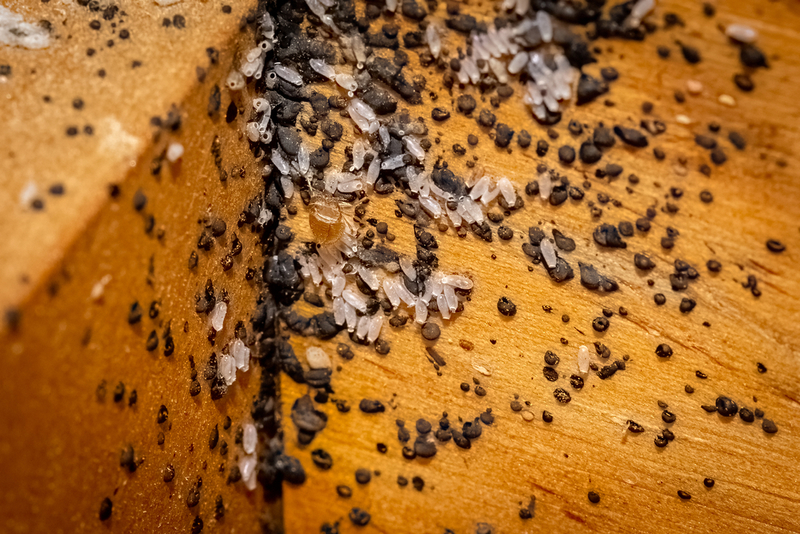Bed bugs are ectoparasites, meaning they feed on the blood of a host animal. Unfortunately, these disturbing pests' choice of host is usually a human. In order to produce eggs, the female bed bug must first have a blood meal. After this meal, she is capable of laying large numbers of eggs. With continued access to blood, she can lay more than 100 eggs in her lifetime.

If you're concerned about bed bugs in your house, there are probably two questions you're asking yourself: “What do bed bug eggs look like?" and “Where do bed bugs lay eggs?" Let's examine the answers to each.
How Do Bed Bugs Feed?
Before jumping into an overview of bed bug eggs, it's important to know a little bit about where and how bed bugs feed. As mentioned, they need blood to survive – and females need it to produce eggs – and most often, this comes from a human.
While bed bugs can travel short distances (up to 20 feet in one night) to find a meal, they generally prefer to hide near their hosts. That's why they're so commonly found in mattresses and furniture.
Bed bugs are nocturnal, so they hide during the day and emerge to feed while you're sleeping or resting, hence the saying, “Sleep tight, don't let the bed bugs bite." Each blood meal lasts around 10 minutes.
Typically, a female bed bug lays between 1 and 7 eggs per day. She can continue doing this for about 10 days after a blood meal, at which point she'll need to feed again to continue laying eggs. Generally speaking, the more blood meals a female gets, the more eggs she produces.
What Do Bed Bug Eggs Look Like?
Bed bug eggs are very small and white to pearl-white in color. They are barrel-shaped and are about the size of a pinhead or a grain of salt. This means they can easily be camouflaged in some of the insects' favorite hiding spaces, including mattresses, especially against light-colored fabrics.
When a female lays eggs, they are covered with a sticky substance that helps adhere them to almost any surface she places them on. If the eggs are more than five days old, they will have a conspicuous dark mark on them that resembles an eye.
Bed bug eggs can be found in single eggs or a group of eggs, and nearly all of them will hatch successfully within 10 days. The time to hatch can depend on temperature. The cooler the temperature, the more time it might take to hatch.
There's usually around the same number of male and female eggs. And because females can produce a large number of eggs, a bed bug population can double every 16 days under ideal conditions.
Where Are Bed Bug Eggs Found?
Once inside a structure, bed bugs do not travel far to feed or lay their eggs. Most eggs are laid in protected sites as close to a food source as possible. These pests can fit into a crack no thicker than a business card and still be able to lay eggs, which means they can lay them almost anywhere.
Because bed bugs usually feed on humans, the most common place to find their eggs is on or near the bed. They are usually laid on mattress seams and joints, but it's also common to find them on the box spring and behind the headboard, if it butts up to or is attached to the wall. You may also see red or black specks near these sites. These markings are bed bug feces, which are made up of partially digested blood. Large concentrations of bed bugs may produce a pungent, sweetish or musty odor caused by pheromone secretions from their scent glands, which indicates an infestation is present.
Bug Larvae in Bed?
If you can have bed bug eggs in your bed, you're probably wondering if they will hatch and become bed bugs in your bed. The short answer is yes. Immature bed bugs are called nymphs. This is because they undergo a simple metamorphosis, that is, a metamorphosis with three phases (egg, nymph, adult). This is different from insects that undergo a complete metamorphosis, or one with four stages (egg, larva, pupa, adult) – think of butterflies.
As with other insects that have a simple metamorphosis, bed bug nymphs closely resemble adults. However, they're translucent or straw-like in color and much smaller. Bed bug nymphs go through five stages before they reach maturity, getting progressively darker in color and larger as they grow.
At the end of each stage, they molt, or shed their exoskeleton, in order to grow. These discarded exoskeletons are a key sign of a bed bug infestation in your home. Exoskeletons can appear anywhere bed bugs and bed bug eggs show up. Again, this is most likely to be in the seams of your mattress or box spring, or other places in and around your bed. The exoskeletons resemble the actual bed bugs, but they are a translucent shell and will vary in size depending on the stages of the insects that shed them.
How to Check for Bed Bug Eggs
Bed bugs and their eggs can be difficult to find. Doing so takes careful and thorough inspection. Take a close look at your bed first. Strip the sheets and bedding, and check every seam and crack. Because eggs are white and so small, they're particularly difficult to find. You may need to get a magnifying glass and a flashlight to help you spot them.
Finding and getting rid of bed bugs is a tough job. In fact, it often requires professional assistance. If you think these unwelcome pests have found their way into your home, don't let the problem get out of control. Schedule your free bed bug inspection with Terminix® today and let the professionals kick these bugs to the curb.

